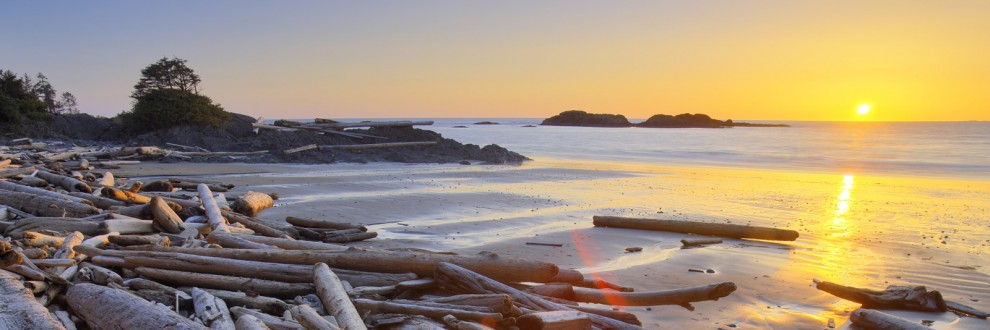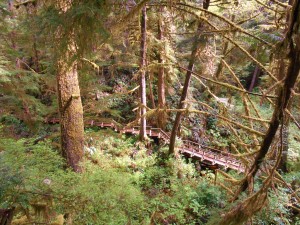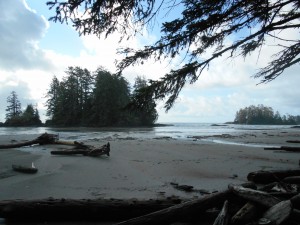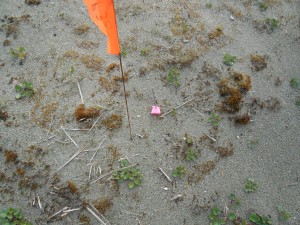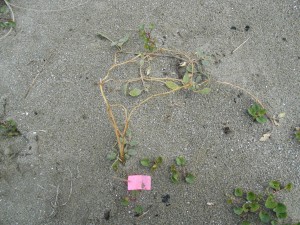Mike arrived to pick me up for work, today, and told me that we’re going on a field trip…
We hiked in along the “trail”, which was actually a fully up-kept wooden walkway that spans magical kilometers through totally dense rainforest. The amount of time and work that goes into something like that is just incredible to fathom…
Schooner Cove was our destination. It’s is the second site of sand dune restoration activity on the Long Beach Unit of Pac Rim. Today’s mission: survey the site since the planting of an endangered species of dune plant — the pink sand verbena.
We reached the Beach, and meandered down it for another kilometer, around a point of land that Mike tells me used to be a campground. Due to budget cuts (and probably some politics with the local Reserve, which is not far away), the campground was shut down. There’s nothing left, anymore… the forest swallowed it up. What a beautiful spot, though — such a shame that so few get to enjoy it.
Well, we kept walking the hard-packed beach (which was actually the sea-floor, as the tide was out), and we came across some wolf tracks (which I forgot to photograph). I had brought my camera, although I’m pretty absorbed by the moment and so make a bad photographer. Nonetheless, we arrived finally at Schooner Cove, and I took pictures of the re-emerging invasive Ammophila (European Beachgrass), and the struggling Pink Sand Verbena…
We surveyed the site, noting locations of successful growths of pink sand verbena…. and another successful plant… Mike noted how the beachgrass was re-emerging from where the excavator had been shipped in to till the sand dune last winter (… huge amounts of money being spent on this project… ). The futility of the whole restoration project still astonishes me, and I can’t wrap my head around it even now, that it’s still ongoing. But most people do feel that it’s good park stewardship, and better for the ecology if we do… you likely know my feelings on it.
Mike also showed me the uVic doctoral study that a student was completing on this section of beach: tarps covered a cordoned-off section of beach, in various squares, some covered, some not. Other squares had been hand-dug, others with a shovel, others with an excavator. The point was to see how various preventative and restorative methods worked in reducing the beachgrass invasion.
When I see all this activity and all these resources being spent on the Dune Restoration Project, I am left with a fundamental question:
- Q: Is the money that Parks Canada is spending on removing this grass really a good expenditure of Canadian tax dollars? Should we not be spending this money in more ethical and creative ways? Destructive methods seem the least beneficial to the ecology of the region, and to the environment in general…
Overall, the nature here is so refreshing for my soul, and the hike to Schooner re-acquainted me with my concerns as an environmentalist. How was I going to incorporate differing perspectives into my restoration lesson plan? No matter how difficult to achieve, I think it is essential that students be made aware of a variety of perspectives on an issue, as that is when the real ‘learning’ happens — when they can decide something for themselves.
